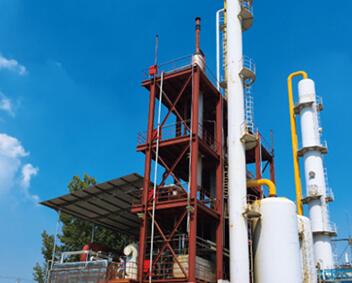造紙廢水主要來源于制漿造紙和復印紙兩個生產過程。制漿是將植物原料中的纖維分離成紙漿,然后進行漂白;抄寫紙是將紙漿稀釋、成型、壓制、干燥、制成的紙。
Papermaking wastewater mainly comes from two production processes of pulp and paper making and photocopy paper. Pulping is to separate the fibers in plant raw materials into pulp, and then carry out bleaching; paper copying is to dilute, shape, press, dry and make pulp.
這兩種方法都會產生大量的廢水。制漿產生嚴重的廢水污染。在洗滌過程中,排放的廢水是黑色和棕色的,這被稱為黑色水。黑水中污染物濃度非常高,BOD高達5-40g /L,含有大量的纖維、無機鹽和色素。漂白過程排出的廢水也含有大量的酸堿物質。造紙機排出的廢水稱為白水,在生產過程中加入了大量的纖維、填料和凝膠。
Both methods produce a lot of waste water. Pulping produces the most serious wastewater pollution. In the washing process, the waste water discharged is black and brown, which is called black water. The concentration of pollutants in black water is very high, BOD is as high as 5-40g / L, which contains a lot of fibers, inorganic salts and pigments. The waste water from bleaching process also contains a lot of acid and alkali substances. The waste water discharged from the paper machine is called white water, and a large number of fibers, fillers and gels are added in the production process.
造紙工業廢水的處理應注重提高回轉率,減少用水量和廢水排放量,積極探索可靠、經濟、有效的處理方法,充分利用廢水中的有用資源。如浮選法可回收白水中的纖維狀固體物質,回收率可達95%,澄清水可重復利用。燃燒法可回收水中的氫氧化鈉、硫化鈉、硫酸鈉等與有機物結合的鈉鹽。
In the treatment of papermaking wastewater, we should pay attention to improving the rotation rate, reducing water consumption and wastewater discharge, actively explore reliable, economic and effective treatment methods, and make full use of the useful resources in the wastewater. For example, the method of flotation can recover the fibrous solid matter in white water, the recovery rate can reach 95%, and the clarified water can be reused. Sodium hydroxide, sodium sulfide, sodium sulfate and other sodium salts combined with organic compounds can be recovered by combustion.
采用中和法調節廢水的pH值。廢水中的懸浮物可通過混凝沉淀或浮選去除。化學沉淀可脫色;生物處理可以去除生化需氧量,對牛皮紙廢水的處理效果更佳。濕法氧化法處理亞硫酸鹽紙漿廢水取得了較好的效果。此外,國內外還采用反滲透、超濾、電滲析等方法。
The pH value of wastewater was adjusted by neutralization method. The suspended solids in wastewater can be removed by coagulation sedimentation or flotation. Chemical precipitation can decolorize; biological treatment can remove biochemical oxygen demand, and the treatment effect of kraft paper wastewater is better. The treatment of sulfite pulp wastewater by wet oxidation method has achieved good results. In addition, reverse osmosis, ultrafiltration and electrodialysis are also used at home and abroad.
以上是
生物脫硫廠家為大家介紹的相關內容,想要了解更多內容,歡迎訪問網站:http://lbflj.com/oldThe above is the relevant content introduced by the bio desulfurization manufacturer. To learn more, please visit the website: http://lbflj.com
